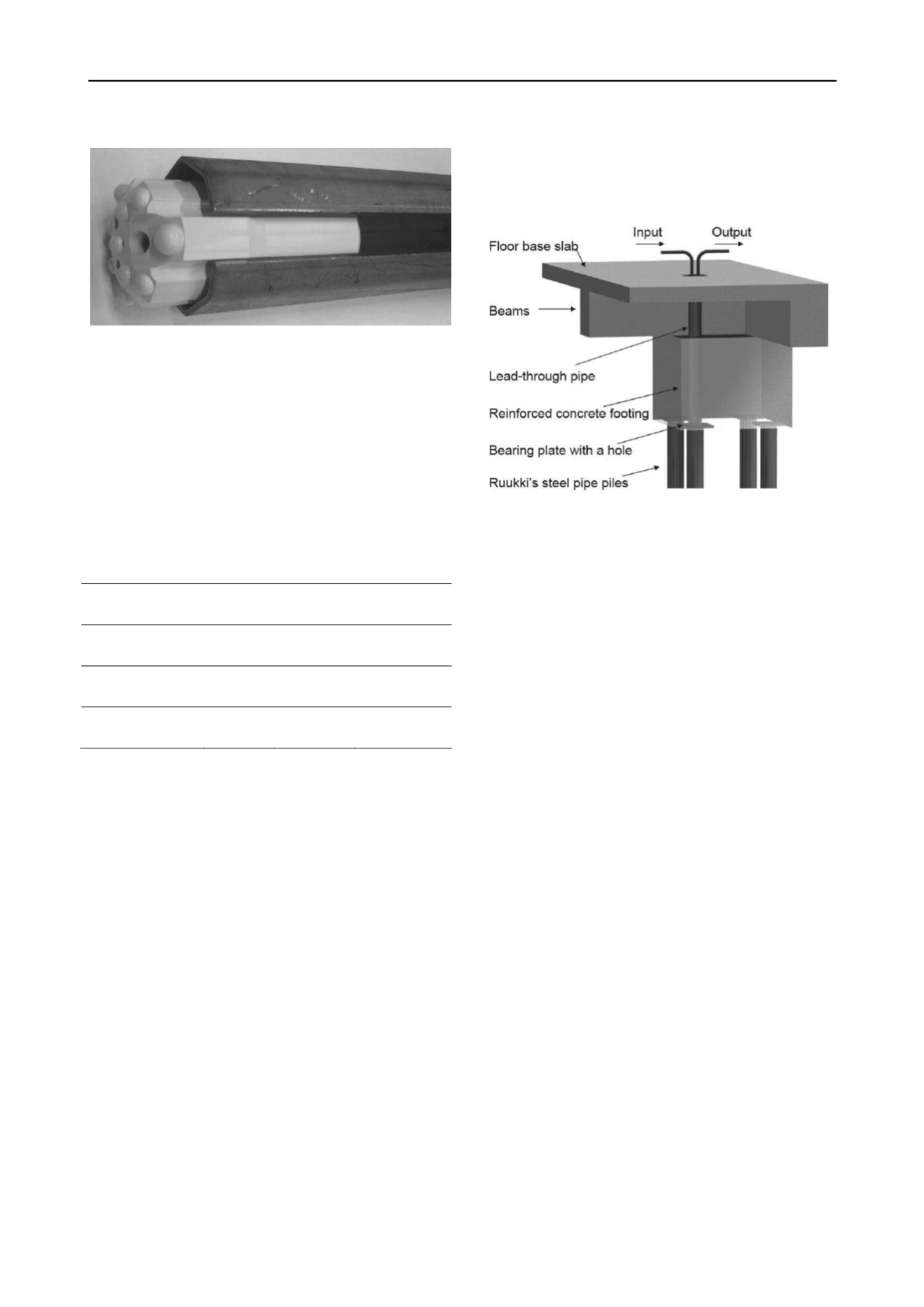
2784
Proceedings of the 18
th
International Conference on Soil Mechanics and Geotechnical Engineering, Paris 2013
Figure 2. Drilling of an open C section can be done using an eccentric
drilling bit.
A new invention has been introduced in Finland to drill an
open section as a structural body of a drilled pile. Open section
drilling can be done using an eccentric drilling bit (Fig. 2) and
the eccentric part of the machinery can be removed from the
pile body through the open side of the steel section. The
drilling bit has been developed by Robit Rocktools Ltd and the
C section has been developed by Emeca Oy. Drilling has been
tested (Table 1) until now using the top hammer method but the
DTH drilling could be applicable, too.
Table 1. Test sites for open section drilling in Finland.
Site
Soil
layers
Pile
diameter
Lengthening
coupler
Masku 2010
gravel,
bedrock
80 mm
no
Espoo 2011
gravel,
clay
80 mm
no
Naantali 2012
clay,
moraine
80 mm
yes
3 ENERGY PILES
The use of energy piles has grown since 1980s when concrete
piles were started to utilize to transfer heating or cooling
energy. When the end bearing steel pipe piles have become
very common in the Nordic countries, development of energy
type micropiles has been an interesting opportunity to face
demand of greener energy and lower energy consumption.
(Uotinen et al 2012)
3.1
Steel pipe piles
The pipe piles are easy applicable to use as energy piles due to
hollow structure of the pile. Steel material has a good thermal
conductivity reducing the thermal resistance of the energy pile.
Steel pipe piles can be installed by driving, drilling, jacking or
vibrating. The minimum outer pile diameter considering the
heat collecting pipes is 88,9 mm but typically diameter for
drilled energy piles is close to 200 mm or more.
3.2
Heat collecting components
Normally, the heat collecting pipes are made from high density
polyethene, diameter between 20 to 40 mm. One or two U
loops of collecting systems (Fig. 3) are installed inside of a steel
pipe pile. Water-ethanol mixture is the most common liquid
used in energy piles. (Uotinen et al 2012)
3.3
Case study: an office building in Finland
The first energy pile building in Finland was constructed to
Jyväskylä. The 6-storey office building, base area ca. 1700 m
2
,
Figure 3. Loops of energy collecting components are installed inside of
a steel pipe pile.
is equipped with 38 energy piles when totally 246 piles of 22 to
29 m length has been driven to fill, clay, silt and moraine
layers.The piles are type RR170/10, RR220/10 and RR220/12,5,
the pile load respectively 691 kN to 1350 kN. In addition, there
are 65 precast concrete piles; all piles were driven with Junttan
PM 20 LC piling rig and with 4 ton hydraulic hammer. The
space between the energy piles varies from 5,5 m to 7,8 m.
(Uotinen et al 2012)
4 DRILLED PILE WALLS
Drilled piles have been used for retaining walls have been
constructed in Finland, Sweden and Norway since 2008.
(Uotinen and Jokiniemi 2012) Drilled pile walls can be used in
demanding soil conditions where installation of conventional
sheet piles can face penetration problems or vibration risks. In
Northern Scandinavia and Finland, hard and large boulders are
common obstacles in the overburden limiting use of
conventional sheet pile and retaining wall methods.
Two variations of drilled pile walls have been introduced
based on either (i) Ruukki´s drilled steel pipe piles (RD piles) or
(ii) an application of open section drilling utilizing C and CT
profiles (Fig. 4). The RD pile wall cases are collected to Table 2
covering large variations of diameter and interlocking systems.
Totally 2150 piles or 24500 m piles have been used for drilled
RD walls until now.
The drilled pile walls can be used as a temporary or a
permanent structure. Typically, the wall has capacity to take
both high vertical and lateral loads when needed. (Uotinen &
Jokiniemi 2012)
5 CONCLUSION
The market share of micropiles and other steel piles is
remarkably high in the Nordic countries, partly due to active
research and development during the past decades. There are
versatile collection of applications available and many e.g.
drilled pile techniques extend the use of piles to design
solutions which are totally new for piles. The energy piles and
the drilled pile walls have great potential for future ground
engineering. Further research and development efforts will be
needed to get all potential benefits linked to the inventions.


